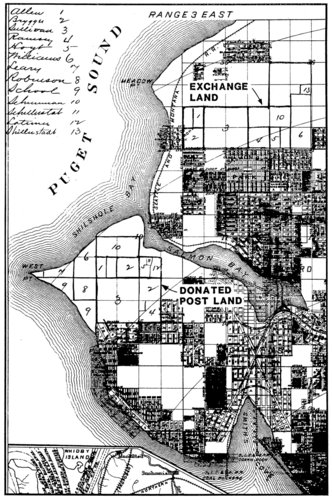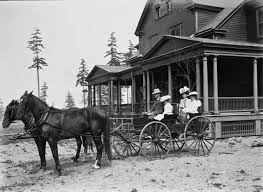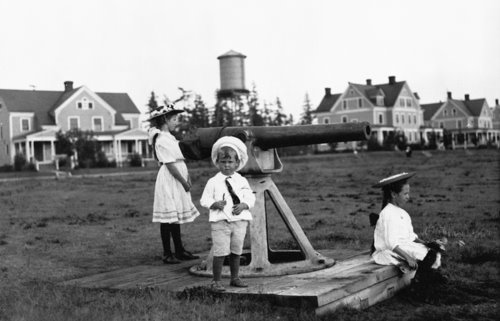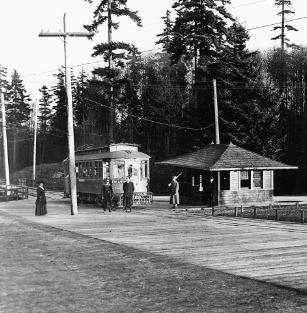MHS Position on Historic Fort Lawton Housing Upcoming Sale
By Monica Wooton.
Past President Magnolia Historical Society (MHS), Board Member
There has been controversy over the expected and long planned-for sale of the historic Fort Houses (Officer’s Row and Non-Commissioned Officers in Montana Circle). This sale comes as a result of a many layered and complicated set of century-long historic events, circumstances and laws.
Then…
After a long, political process with many twists, it was stipulated, by the Army, that: to get the Fort in Seattle land needed to be donated to them. The Seattle Chamber of Commerce, thinking this would be a great economic boon, accepted that proposition. David Chance’s, The Evolution of Intent at Fort Lawton, reports records do not provide a clear picture of the sales, trades and dealings. A fund was raised and a committee was formed by the Chamber to obtain land from original owners. After complicated acquisitions, this land was deeded to the Army.

Seattle Chamber of Commerce map of the
property just to the north of Ballard that was exchanged
in 1897 for land donated on Magnolia to create
Fort Lawton. July 1984.
From The Evolution of Intent at Fort Lawton,
by David Chance.

Ambrose Kiehl and Family outside their Fort Lawton Officer’s Row home. They were the first occupants and lived there from 1899 until 1905.
Photo courtesy of Paul Dorpat.
The Fort waxed and waned during the Spanish American War and WWI. Oddly though, in 1938, the Army felt the Fort was no longer viable and offered to sell it back to the city for $1. According to Magnolia: Making More Memories, “Change the Only Constant: Fort Lawton”: “…to the surprise of the City and rather out of the blue, in 1938 the Army finally did offer the entire property of Fort Lawton to the City of Seattle as a park for the cost of one dollar.
“…The members of the City Council, led by John Dore, a frugal mayor, declined the offer because of the Depression, as they were unsure whether they could bear the cost of maintenance. Fort Lawton would soon begin a new mission; as Chance noted, ‘The next decade and a half was to be the Post’s moment in history.’” During WWII and the Korean War, “Seattle became the third largest Port of Embarkation behind San Francisco and New York. In 1946, a half million people passed through the Seattle Port…
After more twists and turns, Senator Henry Jackson in the late 60’s tried unsuccessfully to make the Fort an Anti-Ballistic Missile Site and much controversy ensued: “Jackson sought to mollify his Seattle critics by making the surplus military installation available for a park. He pushed through the Federal Lands for Parks and Recreation Act [of 1969], which made surplus federal land in metropolitan areas available for parks at little or no cost to local authorities. Cities across the country used the act to acquire federal property as parks.” This Act brought Discovery Park into existence beginning in 1972. (See Snapshot in Time, Queen Anne/Magnolia News, November 23, 2012.)
The Seattle Parks Department Acquisition Summary, supplied by Donald Harris, Property Acquisition Services, Manager outlined what parcels came to the City, for how much and when.
- 390.9 acres – Cost $0. April 17, 1972. Surplused. Beginning acreage for Discovery Park. As a result of protesting in 1970, 20 acres of these are leased for 99 years (renewable) to Indians of All Tribes.
- 127 acres – Cost $0. May 7, 1980. Surplused. More park acreage restored to park and the creation of the original Historic District. Chapel on the Hill included on the acreage was $67,750.
- 2.039 acres – Cost $0. August 1, 2005. Surplused. West Point Lighthouse and two keepers dwellings.
- 11.92 acres – Cost $0 – January 1, 2008 – Surplused. Old barracks demolished and restored to open space as part of the Park.Properties with in-use military housing became subject to privatization through the National Defense Authorization Act of 1996. And, they had to be bought at market rate. “…the Navy through a defined public-private partnership “will divest of several properties…including Fort Lawton…These divestitures will correspond with new/replacement homes constructed nearer to the installations where the service members work.”
- 5.97 acres – Cost $2,775,000 – December 10, 2007 – Capehart Housing – Demolished and restored to open space as part of the Park. Bought by the City.
- 18 acres – Cost $8,325,000 – October 22, 2010 – Capehart Housing – Demolished and restored to open space as part of the Park. Bought by City, County and Federal funds.
- Approximately 531 acres (and, buildings significant and otherwise) in the Park were acquired for a little over $67,000 (Jackson Bill); and, 24 acres were bought for over $11 million (Privatization Act). Then, Officer’s Row and NCO housing (9 acres with the homes protected and landmarked) went up for sale for more millions of dollars.
Fort Lawton’s Reserve Center was surplused by the Army in 2008 and is the last and only property left. It was vacated in 2012. This land and buildings have been going through the complicated Federal Base and Closure Act of 1990 (BRAC), a process that could allow Seattle to acquire them at little or no cost if it meets certain mandated criteria. It is still stalled out in the Department of Housing and Urban Development because of legal considerations. This land remains in limbo. The Cemetery will remain the only Army owned property left inside the Park.
Now…
Friends of Discovery Park could not get a partnership with government and other entities needed to purchase the Officer’s Row and NCO housing because of the cost mandated by the Privatization Act in the time the economic recession was taking hold.
The City moved to insure historic preservation. Guidelines were established in good process. No new construction is allowed, except small changes (pre-approved) to garage/garbage areas. Interiors can be rehabilitated. All other proposed changes must go through the City Landmarks Board for approval. Exteriors and landscapes are protected. There will be the exact number of houses having residents occupy them as they have for over 100 years.
RISE, a small investment firm in Vancouver BC, with all holdings in the Puget Sound, is intending to purchase the houses, rehabilitate them on the interior and sell them each with land around them (a single family neighborhood with a Home Owner’s Association having Covenants, Codes and Restrictions). Thrive Communities, a local firm associated with RISE, will do the property rehabilitation and management.
MHS is working with all local stakeholders to insure Historic Guidelines and the integrity of the Park’s Master Plan are upheld. The first meeting on April 30th was very positive. Notes of that meeting, and all the participants’ names, are available at this link. A community meeting with Department Planning and Development (DPD) to go over the issues of the sale will take place on May 29th at the Magnolia Community Center at 6:30pm.




